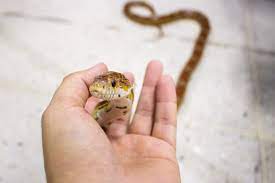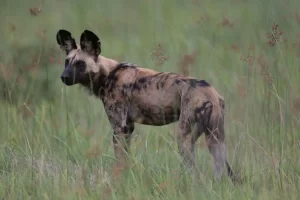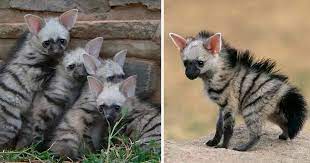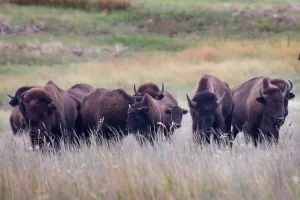The Corn snake is a North American species of rat snake. Their docile nature, reluctance to bite, moderate adult size, attractive pattern, and comparatively simple care make them commonly kept pet snakes. Though superficially resembling the venomous copperhead and often killed as a result of this mistaken identity, Corn snakes are harmless and beneficial to humans.
These snakes are usually orange or yellowish-brown in color with large, black-edged red blotches down their back. There are black and white marks on their bellies, which resemble a checkerboard pattern. Corn snakes are named for their regular presence near grain stores, where they prey on mice and rats that eat harvested corn.

Corn snake
The corn snake is named for the species’ regular presence near grain stores, where it preys on mice and rats that eat harvested corn (maize). The Oxford English Dictionary cites this usage as far back as 1675, whilst other sources maintain that the corn snake is so-named because the distinctive, nearly-checkered pattern of the snake’s belly scales resembles the kernels of variegated corn.
Read the below article to know about the Corn snake which is an elegant north American species of rats as discussed by Pritish Kumar Halder.
Distribution
Corn snakes are found in the Southeastern United States ranging from New Jersey to the Florida Keys and as far west as Utah.

Range of Corn snake
Wild Corn snakes prefer habitats such as overgrown fields, forest openings, trees, palmetto flatwoods, and abandoned or seldom-used buildings and farms. They can also be found in rocky open areas and tropical hammocks.
Description
Adult corn snakes have a body length of 61–182 cm (2.00–5.97 ft).In the wild, they usually live around six to eight years, but in captivity can live to an age of 23 years or more. The record for the oldest corn snake in captivity was 32 years and 3 months. They can be distinguished from copperheads by their brighter colors, slender build, round pupils, and lack of heat-sensing pits.

Corn snake description
Habits and Lifestyle
Corn snakes are solitary creatures. They are active at night and spend most of their daytime underground in burrows or hide under logs, rocks, or loose bark. Typically, these snakes remain on the ground until the age of four months but can ascend trees, cliffs, and other elevated surfaces. In colder regions, Corn snakes brumate during winter. However, in the more temperate climate along the coast, they shelter in rock crevices and logs during cold weather; they also can find shelter in small, closed spaces, such as under a house, and come out on warm days to soak up the heat of the sun.
During cold weather, snakes are less active, so hunt less. Corn snakes have a very sharp sense of smell which they use to hunt their prey. They usually eat every few days and hunt on the ground, climbing trees or in tunnels underground.

Corn snake habit
Diet and Nutrition
Corn snakes are carnivores and eat small rodents, reptiles, or amphibians which they subdue by constriction. They will also climb trees to find unguarded bird eggs.
Mating Habits
Corn snakes usually breed from March to May. Females lay eggs slightly more than a month after mating; 12-24 eggs deposited into a warm, moist, hidden location. Once laid, the female abandons the eggs and does not return to them. The eggs are oblong with leathery, flexible shells. About 10 weeks after laying, the snakelets use a specialized scale called an egg tooth to slice slits in the eggshell, from which they emerge. Young Corn snakes hatch well-developed (precocial) and become reproductively mature when they are 18-36 months old.

Corn snake egg hatching
Corn Snake Appearance
One reason why corn snakes are so popular is because of their extreme diversity in colors and appearance. Breeders are constantly coming up with new variations and color morphs. That being said, not all corn snakes are beauties.
Many of the larger, wild corn snakes take on a “dirty wash” effect, where their colors are muddied by a pigment called melanin. A snake’s look is made of two components: the pattern and the color.
Corn snake patterns can vary and are inherited through genetics. There are five main types of patterning that can be found on corn snakes:
Patterns
Motley or Striped
These patterns happen when the corn snake’s dorsal (back of the snake) blotches are elongated and sometimes joined. This can range from a ladder-like pattern to a completely perfect and even stripe.
Banded
Banded corns are relatively new and still being developed. The goal with a banded corn snake is to have cleanly defined crossbands reaching from the ventral (belly side of the snake) plates all the way down the snake’s back.
Zigzag or Zipper
This pattern phenomenon first cropped up in the 1980s in Florida. Zigzag corns look as if their usual square or rectangular blotches remain connected but have been split lengthwise and spread about, resembling that of a zipper.
Plain and Patternless
Corn snakes can also have a plain belly, which is a belly lacking in the checkerboard pattern that most other corns have.
Patternless corn snakes are also relatively new. Some breeders believe patternless corns to be the result of extreme striping effects. One interesting patternless corn species is the granite morph.

Corn snake stripped
Morphs (Phases)
Corn snakes typically have a row of 30 – 50 large rectangular or square blotches that run down the middle of their backs, with the first blotch usually being connected to a spear-like shape at the top of the snake’s head and the last blotch resting on the tip of the tail. All of the blotches are outlined in black or another dark color, with the blotches themselves ranging in color from red, orange, and brown to a combination of the three.
The background color of the corn snake can be any shade of yellow to orange-red, or it can be more of a light to dark gray, or even tan shade.
Several of the most common naturally occurring corn snake morphs (phases) are as follows:
Oketee Corn
The Oketee Corn is essentially the “perfect corn snake.” The majority of Oketee Corns have deep red dorsal blotches ringed by crisp jet-black borders. Their base color can range from russet to bright orange.
Miami Phase
Many corn snake phases are named after their native region, thus the Miami Corn. Miami Phase Corns typically have a silver-gray base color with a dusting or orange. Their dorsal blotches tend more towards orange than red. Miami Phase Corns tend to be smaller than other corns, averaging just 3-4 feet (91 – 122 cm) in length.
Color Mutations
In addition to the naturally occurring color morphs, breeders have also been able to single out and emphasize certain traits, resulting in several highly desired color mutations. These are:
Amelanism
Meaning “without black pigment,” this is also called albinism. This trait has been bred to result in stunning, brightly colored creamsicle corn snakes and sunglow corn snakes, or it can result in a completely white or candy cane coloring.
Anerythrism
Confusing enough, this is also known as melanistic, but it’s a different type of pigment that’s lacking in anerythristic corns. Corn snakes with this type of mutation lack red and yellow pigments and are predominantly black-and-white, gray, or sepia-toned. Sometimes there are traces of yellow on the throat or chin, but these are usually caused by pigmenting contained in natural foods.
Hypomelanism
Unlike albinism, hypomelanism is when the distribution of black pigment is lessened, and it can result in black areas turning anywhere from a chocolate brown to disappearing entirely. Basically, hypomelanism is a reduction of black pigment that increases the brilliance of the snake’s underlying colors. This can result in lava, sunset, or Christmas colored corn snakes.
Caramel
The caramel color mutation is marked by a heightening of yellow pigment and absence of red and orange, which results in a cream or caramel colored snake.
Lavender
Lavender corn snakes are quite striking, displaying a pinkish purple-gray pattern against a paler white or gray background. Some lavender corns have eerie red eyes that appear to glow, just like in the ghost corn snake.
Piebaldism
This is when abnormal pigmentation results in various sizes of white blotches, or areas replacing part of the snake’s normal coloring.
Population
Population threats
There are no major threats to Corn snakes at present. However, habitat destruction is a local threat in some areas and these snakes are also often killed being mistaken with the venomous copperhead.
Population number
According to IUCN, the Corn snake is locally common and widespread throughout its range but no overall population estimate is available. Currently, this species is classified as Least Concern (LC) on the IUCN Red List and its numbers today are stable.

Corn snake – relationship with humans
Ecological niche
Like all snakes, Corn snakes play a very important ecological role in their environment. They help control populations of small mammals they prey on. Corn snakes are also beneficial to humans as they help control populations of wild rodent pests that damage crops and spread disease.
Reference










